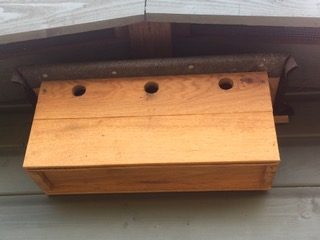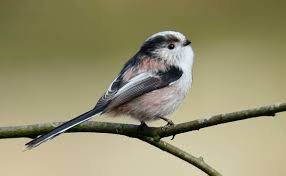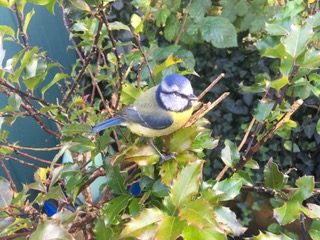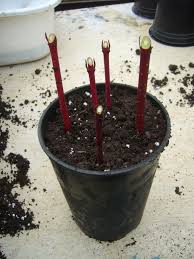 With the clocks going back only a couple of nights ago, we are plunged once more into the realm of short days. Those first few times it is dark by 5.30 are not good for the soul for we gardeners. And Gardener’s World is over for the (calendar) year, as Monty no doubt heads off to sunny climes. Grrrr.
With the clocks going back only a couple of nights ago, we are plunged once more into the realm of short days. Those first few times it is dark by 5.30 are not good for the soul for we gardeners. And Gardener’s World is over for the (calendar) year, as Monty no doubt heads off to sunny climes. Grrrr.
Still, there is plenty other than ‘conventional’ gardening to be getting on with and to make us feel we are achieving something, even at this time of year.
 One job it is very well worth doing about now is to check and clean out all your bird boxes. While birds are not nesting at the moment, they are using boxes as night time roosts, so it is important to make sure they remain clean and sanitary. We found one little sorry carcass that hadn’t made it, so it was important to clean that box especially well. Also, another box hadn’t been used and seemed to be hosting a colony of snails. So, as well as cleaning that one, we’ll also be moving it to a different location – clearly the birds (tits in this case) weren’t happy with the spot we chose for them
One job it is very well worth doing about now is to check and clean out all your bird boxes. While birds are not nesting at the moment, they are using boxes as night time roosts, so it is important to make sure they remain clean and sanitary. We found one little sorry carcass that hadn’t made it, so it was important to clean that box especially well. Also, another box hadn’t been used and seemed to be hosting a colony of snails. So, as well as cleaning that one, we’ll also be moving it to a different location – clearly the birds (tits in this case) weren’t happy with the spot we chose for them
We introduced, for the first time this year, some sparrow terraces to our gardens. Sparrows are highly social birds and like communal living, despite the bickering that seems to go on at the feeders, and the terrace is simply an elongated box with multiple compartments within it. We have gone for 3, although we think anything up to 5 will be acceptable. It was very gratifying to see that all but one of the new compartments (8/9 then) had been nested in, so that was a job well done.
 It is also about the right time to up the amount of food you put out for the birds, if you do feed. Time for the peanuts, fatballs, mealworms, fat pellets, nyger and sunflower seed to come out again. It is becoming an expensive business, that’s for sure. There are mixed views about what we should do for our garden birds during the summer and autumn months. Clearly, there is much more available from natural sources – bugs, seedheads, fruit, rosehips and so on, and birds should be encouraged to use those natural resources. Otherwise, they may adapt not to seek them out at all.
It is also about the right time to up the amount of food you put out for the birds, if you do feed. Time for the peanuts, fatballs, mealworms, fat pellets, nyger and sunflower seed to come out again. It is becoming an expensive business, that’s for sure. There are mixed views about what we should do for our garden birds during the summer and autumn months. Clearly, there is much more available from natural sources – bugs, seedheads, fruit, rosehips and so on, and birds should be encouraged to use those natural resources. Otherwise, they may adapt not to seek them out at all.
However, various bird support groups suggest carrying on feeding right through. We have mixed views, and so to balance the outcomes, we carry on feeding, but at a much wider interval during late summer and autumn. The birds definitely do feed on what’s around them when forced to, but a little supplementary food now will help keep the population healthy and ready to withstand the colder months to come. The first top up Helen did this year (a week or so ago) was rewarded almost instantly with a flock of long-tailed tits arriving on the fatballs and peanuts. Some of the prettiest, slightly cantankerous, little lollipops of birds, but an absolute delight to see in number so close to the house. There were 9 this time, so fingers crossed for more.

The nyger feeder was filled quickly with the beautifully detailed goldfinches, arguing about who gets the best perch, and forming a not very orderly queue when all 8 perches were full. But let’s remember that encouraging birds into the garden is not just to make us smile, (although that is important) they perform a great task in natural pest control – slugs, snails, caterpillars, worms, aphids, leatherjackets and other unidentified grubs etc will all be food sources, giving us a helping hand.
It is time too, to have a look outside and see what sorting tidying might be appropriate for your garden at this time of year. Some like to do a complete “putting to bed”, but we are not quite in that camp. There is something quite charming about the aging and regrouping process our plants go through at this time of year, and its sometimes nice to watch that happen right through to the final collapse. Plus, why hoover up leaves and put them in a box to rot down, when they will rot down equally well where they fall into the bed. However, if you are a tidier, you can trim, snip and poke around now, but leave a bit of top growth on your favourite herbaceous perennials in case we get frosts or a really wet spell which might track down into the plant otherwise.
Once leaf fall has happened, you have some opportunities now with your deciduous shrubs.
The first is to take hardwood cuttings, but for this you need a bit of patience. Take 10-15cm long cuttings, making sure you have a bud just above the base and one at the top of the cutting. The bud at the base is important because it is those cells which will mutate into root cells and start off the new plant. The bud at the top is so you can see new leaves when new growth is taking place. Plunge these into a pot of moist, gritty compost and put in a cool sheltered place for at least a year, because it will take that long, really.
Do not be tempted to tug on them in the interim, even if you see a new leaf at the top, as that can be triggered by the cutting without it having put down any roots at all (oh, how often have it I done that?……..). We are actually doing this with some bits that broke off plants during the recent very strong winds – every cloud has a silver lining and all that……..It’s worth a try, anyway, and doesn’t require much work.
 Secondly, when a shrub is bare of leaves, it is much easier to see its framework and therefore, how you need to prune it for best effect. If it looks good naked, it will look even better when re-clothed with leaves next year. So use this time to re-shape anything that may have got a bit out of control, too big, one-sided or just plain ugly.
Secondly, when a shrub is bare of leaves, it is much easier to see its framework and therefore, how you need to prune it for best effect. If it looks good naked, it will look even better when re-clothed with leaves next year. So use this time to re-shape anything that may have got a bit out of control, too big, one-sided or just plain ugly.
And finally, have you ever tried layering a shrub? We have done by accident and by design, and trust us, it works really well.
The “by accident” one was burying the centre of a branch of philadelphus (the delightfully scented mock orange) during some reworking of a bed. Result – one brand new healthy philadelphus which can now be moved elsewhere. A new philadelphus
 The “by design” was a little parahebe (wonderful edge of border plant with intricately painted flowers – the sort you see best by peering up close) which had become very woody around its base. We weren’t sure if it would tolerate hard pruning, so hard pruned most of it, and layered a healthy stem. Just scrape the bark or outer from the stem that is to be buried just a little (again, you are looking for those cells to mutate into root cells) and bury the scraped area, leaving it attached to the main plant. Result – a nice new plant which can separated now – it took 6-8 months to get roots down. And even better, the main plant quite enjoyed the hard pruning and is now looking much better.
The “by design” was a little parahebe (wonderful edge of border plant with intricately painted flowers – the sort you see best by peering up close) which had become very woody around its base. We weren’t sure if it would tolerate hard pruning, so hard pruned most of it, and layered a healthy stem. Just scrape the bark or outer from the stem that is to be buried just a little (again, you are looking for those cells to mutate into root cells) and bury the scraped area, leaving it attached to the main plant. Result – a nice new plant which can separated now – it took 6-8 months to get roots down. And even better, the main plant quite enjoyed the hard pruning and is now looking much better.
Gardening often appears to the novice to be full of strict rules, and we think this makes it forbidding to those who don’t feel they can remember or learn it all. But our view is that it is about experimentation as well, a bit like cooking. Give it a try, you never know what might happen and the outcome might be really lovely!
Well, next month, we won’t be able to avoid the dreaded C word (No! Not THAT one!) and if you happen to be free on 2nd December, keep an eye on Pengelly – we have something special up our sleeves……
Sarah Daniel and Helen Robins, Pengelly Garden Centre

